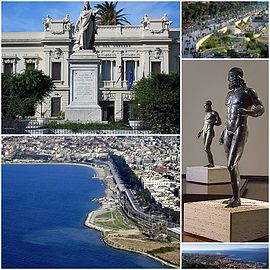|
Greek city of Rhegion in Bruttium (Italy)
Bronze 20mm (7.49 grams) Struck 351-280 B.C.
Reference: SNG ANS 689-92; HN Italy 2534b
Facing lion’s scalp.
Laureate head of Apollo left.
Destroyed by Dionysios I of Syracuse in 387 B.C. and restored
some years alter
by Dionysios II, 356-350 B.C.
You are bidding on the exact item pictured,
provided with a Certificate of Authenticity and Lifetime Guarantee of
Authenticity.
After
Cumae
, Reggio is one of the oldest Greek
colonies in southern Italy. The colony was settled by the inhabitants of
Chalcis
and
Messenia
in 720 BC on the site of an older
settlement, Erythrà (Ερυθρά), meaning “the red one”.
This dated back to the 3rd millennium BC and was established by the
Ausones
. The last Ausonian ruler was the
legendary king Italus
(from whom the name of Italy is
derived).[4]
King Iokastos is buried on the Punta Calamizzi promontory, called “Pallantiòn”,
where Greek settlers later arrived. The colony retained the earlier name of “Rhegion”
(Ρήγιoν).
Reggio was one of the most important cities in
Magna Grecia
, reaching great economic and
political power during the 5th and 6th centuries BC under the
Anaxilas
government. It allowed Reggio to rule
over all the
Strait
, including
Zancle
(modern
Messina
). Later, the polis of Rhegion reached
great artistic and cultural heights with its philosophic
Pythagorean
school, as well as sculpture and
poetry schools, from where came leaders such as
Pythagoras of Rhegium
and
Ibycus
. Later, Rhegion allied with
Athens
during the
Peloponnesian War
but in 387 BC, the city was
taken by the
Syracusans
.
As an independent city, Rhegium was an important ally and “socia navalis” of
Rome. Then during the Imperial age it became one of the most
important and flourishing cities of southern Italy because it was the seat of
the “Corrector”, the Governor of the “Regio II Lucania et Bruttii” (province of
Lucany and Brutium). It was devastated by several major
earthquakes
and associated
tsunami
during the
Roman Empire
when it was called “Rhegium Julium.”
It was a noble Roman city.
During the Byzantine Age, Reggio became the capital of the “metropolis of the
Byzantine possessions in southern Italy”, and later capital of the
Duchy of Calabria
and linchpin of the Greek
church in Italy. During the 8th century, the city became a
Holy See
.

In
Greek
and
Roman mythology
, Apollo
,
is one of the most important and diverse of the
Olympian deities
. The ideal of the
kouros
(a
beardless youth), Apollo has been variously recognized as a god of light and the
sun; truth and prophecy;
archery
;
medicine and healing; music, poetry, and the arts; and more. Apollo is the son
of Zeus
and
Leto, and has a
twin
sister, the chaste huntress
Artemis
.
Apollo is known in Greek-influenced
Etruscan mythology
as Apulu. Apollo was worshiped in both
ancient Greek
and
Roman religion
, as well as in the modern
Greco
–Roman
Neopaganism
.
As the patron of Delphi
(Pythian Apollo), Apollo was an
oracular
god — the prophetic deity of the
Delphic Oracle
.
Medicine and healing were associated with Apollo, whether through the god
himself or mediated through his son
Asclepius
,
yet Apollo was also seen as a god who could bring ill-health and deadly
plague
as well as one who had the ability to cure. Amongst the god’s
custodial charges, Apollo became associated with dominion over
colonists
, and as the patron defender of herds and flocks. As the leader of
the Muses
(Apollon
Musagetes) and director of their choir, Apollo functioned as the patron god
of music and poetry
.
Hermes
created
the lyre
for him,
and the instrument became a common
attribute
of Apollo. Hymns sung to Apollo were called
paeans
.
In Hellenistic times, especially during the third century BCE, as Apollo
Helios he became identified among Greeks with
Helios
,
god of
the sun
, and his sister Artemis similarly equated with
Selene
,
goddess
of the moon
.
In Latin texts, on the other hand, Joseph Fontenrose declared himself unable to
find any conflation of Apollo with
Sol
among the
Augustan poets
of the first century, not even in the conjurations of
Aeneas
and
Latinus
in
Aeneid
XII
(161–215).
Apollo and Helios/Sol remained separate beings in literary and mythological
texts until the third century CE.
|









